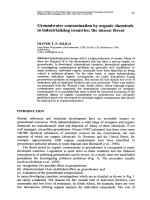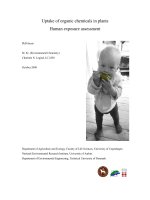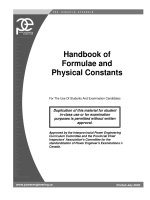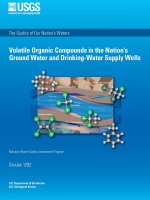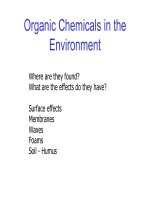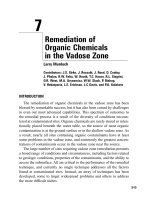ANAEROBIC BIODEGRADATION RATES OF ORGANIC CHEMICALS IN GROUNDWATER: A SUMMARY OF FIELD AND LABORATORY STUDIES pdf
Bạn đang xem bản rút gọn của tài liệu. Xem và tải ngay bản đầy đủ của tài liệu tại đây (792.4 KB, 182 trang )
ANAEROBIC BIODEGRADATION RATES
OF ORGANIC CHEMICALS
IN GROUNDWATER:
A SUMMARY OF
FIELD AND LABORATORY STUDIES
Work Assignment Manager Dr. Zubair A. Saleem
and Technical Direction: U.S. Environmental Protection Agency
Office of Solid Waste
Washington, DC 20460
Prepared by: HydroGeoLogic, Inc.
1155 Herndon Parkway, Suite 900
Herndon, VA 20170
Under Contract No. 68-W7-0035
U.S. Environmental Protection Agency
Office of Solid Waste
Washington, DC 20460
June 1999
i
TABLE OF CONTENTS
Page
ACKNOWLEDGMENTS iii
1.0 INTRODUCTION 1
2.0 REVIEW OF BIODEGRADATION STUDIES 2
3.0 REFERENCES 8
APPENDIX A CRITERIA FOR EVALUATING BIODEGRADATION RATE
(LABORATORY STUDIES) A-1
APPENDIX B CRITERIA FOR EVALUATING BIODEGRADATION RATE
(FIELD STUDIES) B-1
APPENDIX C CRITERIA FOR EVALUATING BIODEGRADATION
RATE STUDIES (Syracuse Research Center) C-1
APPENDIX D LABORATORY STUDIES FOR ALL COMPOUNDS D-1
APPENDIX E FIELD STUDIES FOR ALL COMPOUNDS E-1
APPENDIX F LABORATORY AND FIELD STUDIES FOR ALL COMPOUNDS F-1
APPENDIX G REFERENCES FOR ALL COMPOUNDS G-1
ii
LIST OF FIGURES
Page
Figure 2.1 Temperature of Groundwater in the United States
at Depths of 10-20 meters (Collins, 1925) 4
LIST OF TABLES
Page
Table 2.1 Summary of Rate Constants 5
iii
DISCLAIMER
The work presented in this document has been funded by the United States Environmental Protection
Agency. Mention of trade names or commercial products does not constitute endorsement or
recommendation for use by the Agency.
ACKNOWLEDGMENTS
A number of individuals have been involved with the project. Dr. Zubair A. Saleem of the U.S.
EPA, Office of Solid Waste, Washington, D.C., provided overall technical direction and review
throughout this work. This report was prepared primarily by Mr. Jaideep Gadgil, with assistance
from Mr. Sean Stanford all of HydroGeoLogic, Inc. Dr. Edward Bouwer of the Johns Hopkins
University provided valuable technical consultation on the microbiological aspects throughout
this effort. Useful inputs provided by many other EPA's scientists and microbiologists are
greatly appreciated. Dr. John Wilson of the U.S. EPA, NRMRL, Ada, OK, provided the
continued leadership on microbiological issues based on his extensive field as well as laboratory
experiences. Dr. John Rogers of the U.S. EPA, NHEERL, Gulf Breeze, FL, helped with the
conceptualization of microbial processes and mechanisms represented in the protocol, played a
key role in the laboratory protocol developed earlier and published in the Federal Register and
provided continuity with the previous efforts. Drs. Parmelli Pritchard, formerly with U.S. EPA,
and Bob Boethling, OPPTS, U.S. EPA, Dr. Jack Jones of the U.S. EPA, Ecosystems Support
Division, Athens, GA, was helpful throughout this review project. The Chemical Manufacturers
Association, along with other industrial groups: American Petroleum Institute; American Forest
and Paper Association; Edison Electric Institute; National Council of the Paper Industry for Air
and Stream Improvement; coordinated and provided initial draft criteria and developed the data
through the Syracuse Research Institute.
1
1.0 INTRODUCTION
Solid and hazardous wastes may pose a considerable threat to the health of humans and the environment.
Under the Resource Conservation and Recovery Act (RCRA) of 1976 the U.S. EPA is appointed the task of
managing these risks through the development and implementation of regulations. To this end, the EPA
develops and uses fate and transport mathematical/computer models to aid in the assessment of risk from
waste management practices. The input parameters of these models may be used to describe, in mathematical
terms, the physical and chemical properties of actual landfill sites. These models may be used to develop a
probability distribution of concentrations by performing a myriad of simulations, each time selecting sites
parameters from a nation-wide database. This technique is known as Monte Carlo analysis and has proven
a useful tool in risk analysis.
The EPA’s Composite Model for Leachate Migration with Transformation Products (EPACMTP: U.S. EPA,
1996) is the subsurface fate and transport model which EPA’s Office of Solid Waste implements on a
nationwide basis using Monte Carlo analysis techniques. The implementation procedure requires nationally
representative distributions of first order biodegradation rates.
EPA uses anaerobic biodegradation rates in the subsurface fate and transport model. The Agency considers
that although anaerobic biodegradation is not the slowest activity, it is less likely that data collected under
anaerobic conditions would lead to an overestimation of the degradation rate. In general, the concentrations
of oxygen and nitrate are insignificant in ground waters that have been impacted with leachate from landfills.
This condition results from prior microbial consumption of oxygen or nitrate that was supported by the
electron acceptor demand of materials in the landfill leachate. Consequently, the rate of supply of oxygen
and nitrate into impacted ground waters is slow. The rate of supply is limited by mass transfer processes
from ground water that has not been impacted (and as a consequence has oxygen and nitrate available) into
the plume impacted with leachate from a landfill. As a result, the only microbial processes that are generally
available for biodegradation of hazardous organic compounds in ground water impacted with leachate from
landfills are the processes of iron reduction, sulfate reduction, and methanogenesis (Krumholz et al, 1996).
Therefore, EPA considers selected rate constants provided by laboratory and field studies that were conducted
under the iron reducing, sulfate reducing, or methanogenic conditions to be the rate constants that are
appropriate for use in EPACMTP. EPA does not consider rate constants provided by laboratory and field
studies that were conducted under aerobic or nitrate reducing conditions to be appropriate for use in
EPACMTP.
EPA developed a protocol to generate national distributions of anaerobic biodegradation rates for organic
chemicals for use in the model (53 FR 22300, June 15, 1988). The protocol requires collecting samples from
six sites: three sites in the northern half of the United States; and three sites located in the southern half of
the country. Ideally, these six sites will represent the various pH and redox environments prevalent in the
country. However, the protocol has not been implemented widely by the industry so far. Meanwhile, many
laboratory and field studies on the anaerobic biodegradation of chemicals have become available since the
protocol was developed more than ten years ago. Suggestions were made to critically evaluate these studies
and incorporate the results in modeling. Therefore, EPA convened a workshop in Atlanta, Georgia, on
anaerobic biodegradation of organic chemicals in 1997. Representatives from academia, industry and the
EPA participated in discussions. Written comments from an environmental group were also considered at the
workshop. Based on these discussions and other inputs from EPA scientists, the Agency developed criteria
for the evaluation of the field as well as laboratory studies. The criteria are listed in Appendices A and B
(laboratory and field studies, respectively).
2
At the workshop, industry representatives provided a report summarizing field and laboratory studies on
anaerobic biodegradation of organic compounds. The report entitled “Anaerobic Biodegradation of Organic
Chemicals in Groundwater: A Summary of Field and Laboratory Studies” was prepared for the American
Petroleum Institute (API) and others by the Syracuse Research Center, 1997. All the research articles
reviewed in the report were also submitted to EPA by the API. The criteria used by Syracuse Research
Corporation are presented in Appendix C. Since the criteria used by Syracuse Research Center (Appendix
C) to review research papers was less stringent than the criteria decided upon at the workshop, EPA
conducted a second review of the API-submitted Syracuse Research Center Report. In addition, EPA
conducted a literature review to collect additional studies on biodegradation of various organic chemicals
(both laboratory as well as field). For purposes of this report, biodegradation is defined as “removal of a
compound from ground water through biological activity”. Only studies which were conducted with aquifer
materials under anaerobic conditions were selected for review. In addition studies carried out on mixtures
of compounds, and studies where the aquifer material was seeded with microorganisms from other sources
were not included. The studies were then evaluated to see if they satisfied the proposed EPA criteria.
Biodegradation rates from studies which met the proposed criteria were used to develop a distribution of first
order rates to be used as potential input to the EPA’s subsurface fate and transport model.
2.0 REVIEW OF BIODEGRADATION STUDIES
The studies submitted by Syracuse Research Center were divided into field and laboratory studies and the
results from these studies are summarized separately. Results of a study were rejected if the study did not
satisfy the criteria indicated as unacceptable in Appendix A or B. Appendices D, E, F, and G summarize
the review of available biodegradation studies satisfying the proposed EPA criteria (Appendices A & B). The
laboratory studies are summarized in Appendix D and the field studies are summarized in Appendix E.
Appendix F has tables summarizing both field and laboratory studies for each compound. The references
for each compound are listed in Appendix G. A summary of the distribution of rates for each compound is
provided in Table 2.1.
Results of both field and laboratory studies are considered for the development of biodegradation rates for
use in the model. Each category (field or laboratory) is further subdivided based on the temperature, pH and
the redox regime. The biodegradation rate of a chemical depends, among other factors, on both the
temperature and pH of the subsurface environment at the site. The subsurface reducing environment was
assumed to be grouped into two broad categories: methanogenic; and sulfate reducing. Studies which
identified iron reducing conditions were grouped under sulfate reducing. Studies which were purely
denitrifying were not included as denitrification is believed to occur predominantly in the vadose zone
(Krumholz et al, 1996) . If a study met all criteria but was missing either temperature or pH or both, then
pH and temperature were assigned to the study as follows:
1) pH: assume neutral range (6-8), for both laboratory and field; and
2) Temperature: assume 25 C for laboratory, and for field studies refer to the nationwide
o
distribution of temperature shown in Figure 2.1.
The pH regimes were grouped as: acidic (<6), neutral (6-8), and alkaline (>8). Two distinct temperature
ranges were considered (# 15 C and >15 C). Each table includes the lag time for degradation where
o o
reported and any special observations regarding the study. If a multiple redox regime was reported in the
study (e.g., SO /CH /NO ), the study was classified under the first relevant redox regime reported, in this
4 4 3
case sulfate reducing. If no redox regime was reported the study was classified as sulfate reducing. If
multiple studies were conducted at a site, a simple average was computed for the biodegradation rate and the
average was used. The average was computed so that one site may not unduly bias the distribution of rate
constants. The individual rates are also reported in parentheses following the average.
3
Information from the tables in Appendix F for each compound is used in the subsurface Monte-Carlo fate and
transport modeling. In a Monte-Carlo realization, a site is selected along with the subsurface temperature
and the pH. The reducing environment is randomly chosen, each environment having an equal likelihood
of being selected. Then an anaerobic biodegradation rate is picked from the appropriate cell of the table
corresponding to the selected reducing environment (the rates listed within a cell all have an equal likelihood
of being chosen). The rate is then used for that site in the analysis. For the next Monte Carlo site realization,
the model then selects a rate from the table based on the temperature, pH, and either methanogenic or sulfate
reducing environment at random with replacement. The process is repeated for the total number of Monte
Carlo realizations.
4
Figure 2.1 Temperature of Groundwater in the United States at Depths of 10-20 meters (Collins, 1925)
55
Table 2.1
Summary of Rate Constants
CAS Number / Chemical Name Yield ProductEstimate Min Max Median Deviation Type
Rate Constant (1/day)
Molar ReactionLikely Standard Distribution
Most
000071-43-2 / Benzene 0 0 0.071 0 0.0152 Not Identified
000108-88-3 / Toluene 0.02 0 0.186 0.02 0.0372 Not Identified
000100-41-4 / Ethylbenzene 0.0031 0 0.46 0.0031 0.0762 Not Identified
000108-38-3 / m-Xylene 0.006 0 0.32 0.006 0.0675 Not Identified
000095-47-6 / o-Xylene 0.004 0 0.21 0.004 0.0468 Not Identified
000106-42-3 / p-Xylene 0.0052 0 0.17 0.0052 0.0367 Not Identified
000056-23-5 / Carbon Tetrachloride 0.16343 0 1.73 0.16343 0.572 Not Identified
000067-66-3 / Chloroform 0.0315 0.004 0.25 0.0315 0.0884 Not Identified
000107-06-2 / 1,2-Dichloroethane 0.0076 0.0076 0.0076 0.0076 N.A. Not Identified
000075-09-2 / Dichloromethane 0.0064 0.0064 0.0064 0.0064 N.A. Not Identified
000079-34-5 / 1,1,2,2-Tetrachloroethane N.A. N.A. N.A. N.A. N.A. Not Identified
000127-18-4 / Tetrachloroethylene 0.00186 0 0.071 0.00186 0.0223 lene
Trichloroethy
000071-55-6 / 1,1,1-Trichloroethane 0.00355 0.041 0.00355 0.0130 Not Identified
0
000079-00-5 / 1,1,2-Trichloroethane N.A. N.A. N.A. N.A. N.A. Not Identified
000079-01-6 / Trichloroethylene 0.0016 0.00082 0.04 0.0016 0.00889 Not Identified
000075-01-4 / Vinyl Chloride 0.00405 0 0.0582 0.00405 0.0139 Not Identified
6
Table 2.1 (continued)
Summary of Rate Constants
CAS Number / Chemical Name Yield ProductEstimate Min Max Median Deviation Type
Rate Constant (1/day)
Molar ReactionLikely Standard Distribution
Most
000108-95-2 / Phenol 0.032 0 0.2 0.032 0.0651 Not Identified
000095-48-7 / o-Cresol 0.005 0 0.034 0.005 0.0172 Not Identified
000108-39-4 / m-Cresol 0.029 0.0029 0.033 0.029 0.0138 Not Identified
000106-44-5 / p-Cresol 0.037 0.035 0.048 0.037 0.007 Not Identified
000120-83-2 / 2,4-Dichlorophenol 0.016 0 0.12 0.016 0.0501 Not Identified
000088-06-2 / 2,4,6-Trichlorophenol N.A. N.A. N.A. N.A. N.A. Not Identified
000087-86-5 / Pentachlorophenol 0 0 0 0 0 Not Identified
000075-69-4 / Trichloroflouromethane
(CFC-11) 0.0016 0.0016 0.0016 0.0016 N.A. Not Identified
000075-71-8 / Dichlorodifluoromethane
(CFC-12) 0 0 0 0 N.A. Not Identified
000076-13-1 / 1,1,2-Trichloro-
1,2,2-trifluoroethane (CFC 113) 0 0 0 0 N.A. Not Identified
000067-64-1 / Acetone N.A. N.A. N.A. N.A. N.A. Not Identified
000078-93-3 / Methyl Ethyl Ketone N.A. N.A. N.A. N.A. N.A. Not Identified
000108-10-1 / Methyl Isobutyl Ketone N.A. N.A. N.A. N.A. N.A. Not Identified
000064-19-7 / Aceic Acid N.A. N.A. N.A. N.A. N.A. Not Identified
000103-32-2 / Phenylacetic Acid N.A. N.A. N.A. N.A. N.A. Not Identified
000083-32-9 / Acenaphthalene 0.0043 0.0043 0.0043 0.0043 N.A. Not Identified
000086-73-7 / Fluorene 0.00015 0 0.00145 0.00015 0.00069 Not Identified
Table 2.1 (continued)
Summary of Rate Constants
CAS Number / Chemical Name Yield ProductEstimate Min Max Median Deviation Type
Rate Constant (1/day)
Molar ReactionLikely Standard Distribution
Most
000090-12-0 / 1-Methylnaphthalene 0 0 0.057 0 0.0214 Not Identified
000091-20-3 / Naphthalene 0 0 0.03 0 0.00791 Not Identified
000085-01-8 / Phenanthrene N.A. N.A. N.A. N.A. N.A. Not Identified
000092-52-4 / 1,1'-Biphenyl 0.00016 0 0.019 0.00016 0.00944 Not Identified
000098-82-8 / Cumene 0 0 0 0 N.A. Not Identified
000123-91-1 / Dioxane 0 0 0 0 N.A. Not Identified
000067-56-1 / Methanol 0.036 0 0.34 0.036 0.0697 Not Identified
000098-95-3 / NitroBenzene 0.0037 0.0037 0.1168 0.0037 0.0427 Not Identified
000110-86-1 / Pyridine 0.01 0 0.02 0.01 0.0102 Not Identified
000100-42-5 / Styrene 0 0 0 0 N.A. Not Identified
000108-67-8 / 1,3,5-Trimethylbenzene 0 0 0.0039 0 0.00174 Not Identified
Notes:
C An N.A. in all columns for a compound indicates no study met the proposed criteria.
C An N.A. in the standard deviation column for a compound indicates that there was only one study that met the proposed criteria and so it is not
possible to calculate a standard deviation.
8
3.0 REFERENCES
Collins , W.D., Temperature of water available for individual use in the United States: U.S. Geol. Surv.
Water Supply Papers 520-F, p97-104, 1925.
Krumholz, L.R., Caldwell, M.E., and Suflita, J.M., Biodegradation of 'BTEX' hydrocarbons under
anaerobic conditions, pages 61 through 99 in Bioremediation: Principles and Applications, R.L.
Crawford and D.L. Crawford, Cambridge University Press, 1996.
Syracuse Research Center. Anaerobic Biodegradation of Organic Chemicals in Groundwater: A Summary
of Field and Laboratory Studies, SRC TR-97-0223F, 1997.
U.S. EPA, EPA’s Composite Model for Leachate Migration with Transformation Products (EPACMTP):
Background Document, Office of Solid Waste, Washington, D.C., 20460, 1996.
A-1
APPENDIX A
CRITERIA FOR EVALUATING BIODEGRADATION RATE
(LABORATORY STUDIES)
Italicized criteria are common with Syracuse Research Corporation’s criteria.
A.1 LABORATORY MICROCOSMS
1. *The experiment should have been conducted with aquifer materials and aquifer bacteria.
2. *A proper control study should have been conducted to separate abiotic losses from biotransformation.
3. * Scaling factors for normalizing reaction rate (e.g. dry cell mass) should not have been used. If a
scaling factor was used, it should be reported so that it is possible to calculate a first order rate.
4. * Concentration decrease with time should be documented in the study.
5. Experimental Conditions
C * No artificial growth media should be used in the microcosm study.
C * The experiment should be carried out under anaerobic conditions.
C * In case of a volatile contaminants, there should be no head space in the flask in which the
study is carried out.
C The incubation should be carried out under conditions that closely replicate the subsurface
environment in terms of temperature, pH, and light conditions. The incubation should be
carried out in the dark.
6. The experiment should have good mass balance. That is, the loss of parent organic carbon should be
accounted for by the intermediates and products. Are other products generated in stoichiometric
proportions?
7. If the target compounds were administered to the microcosm using a carrier solvent, how was this
accomplished? If a carrier solvent was used, this could potentially alter the consumption of electron
donors and acceptors. Was a control done to account for the effect of the carrier solvent?
8. The soil/water ratio in the microcosms and the rate constants derived from the data should accurately
reflect the in situ soil/water ratio.
9. Time dependency of rate data. Criteria for statistical analysis of data (e.g., questions regarding the
degree of replication or standard error).
(To fit a first order model ideally there should be a concentration decrease of at least two orders of
magnitude. However, it is recognized that in most cases it is possible to get only an order of magnitude
decrease.)
A-2
A.2 BATCH AND COLUMN STUDIES:
1. The column should be packed and operated under anaerobic conditions. The column must be large
enough to prevent wall effects (i.e. column diameter 20 times the grain diameter).
2. The chemistry of the water passed through the column (or batch reactor) must be similar to the
composition of the groundwater at the site.
3. * A tracer study must be conducted to characterize the hydraulic properties of the column (e.g., mean
fluid residence time and hydrodynamic dispersion).
4. The flow velocity through the column/batch reactor should mimic the groundwater flow velocity at
the site.
5. The feed reservoirs, feed lines, and effluent lines need to be periodically sterilized to
prevent/minimize microbial contamination of the column.
6. The column needs to be operated long enough to obtain stable effluent concentrations in order to
establish proper breakthrough and steady-state reaction processes.
7. In order to accurately assess the biodegradation rate within the column, samples along the column
length (using multiple side ports) must be collected to determine the concentration profile(s) within
the column (i.e., concentration versus length).
These criteria are in addition to the criteria for evaluating laboratory microcosm studies.
*Criteria for acceptance/rejection of study.
B-1
APPENDIX B
CRITERIA FOR EVALUATING BIODEGRADATION RATE
(FIELD STUDIES)
1. * The study should be conducted in the anaerobic portion of the plume.
2. * A tracer study should be carried out that can be used to estimate the processes of dilution, sorption,
or volatilization that can contribute to attenuation of contaminants.
3. * If a transport model was employed to estimate a biodegradation rate, reasonable parameter values
should be used to describe dispersion and sorption processes. The model used should be appropriate
to the hydrogeologic setting and should have been verified.
4. *Data on concentration decrease with time should be reported in the study.
5. No scaling factor should be used to normalize the data. If a factor is used the study must document
the factor so that a first order rate can be calculated.
6. Time dependency of rate data. Criteria for statistical analysis of data (e.g., questions regarding the
degree of replication or standard error).
(To fit a first order model ideally there should be a concentration decrease of at least two orders of
magnitude. However, it is recognized that in most cases it is possible to get only an order of magnitude
decrease.)
C-1
APPENDIX C
CRITERIA FOR EVALUATING BIODEGRADATION RATE STUDIES
(Syracuse Research Center)
LABORATORY MICROCOSMS
1. Study Conducted Under Anaerobic Conditions
2. Experiment Conducted With Grab Samples of Aquifer Material or Ground Water
3. Study Has Controls to Determine Abiotic Losses
4. Need Data on Concentration Decrease With Time
FIELD STUDIES
1. Studies of Anaerobic Portion of Aquifer System
2. Suitable Conservative Tracer Other Than Target Compound Available to Correct for Dilution,
Sorption, Advection and Dispersion Processes
3. Need Data on Concentration Decrease With Time/Distance (Need flow velocity to correlate distance
with time)
D-1
APPENDIX D
LABORATORY STUDIES FOR ALL COMPOUNDS
D-2
Table D.1
Summary Table for Anaerobic Biodegradation Rate Constants for Benzene According to EPA Protocol
(Laboratory Studies)
Temp.
( C) pH CommentsRate (1/day) Ref. Rate (1/day) Ref.
o
Methanogenic Sulfate Reducing
# 15
<6 0 20 0 15 No Redox Regime Given
1 1
6-8
0.0015 9 Meth/Fe/Mn
2 2
0 2 0.047* 11 Meth/SO
3 3
4
*8 days lag
0.052* 11 * 21 days lag
0.071 27 0 3 Meth/Fe
14 11 14
No Redox Regime Given
11
0 19 0.0029 17 No Redox Regime Given
10 10
0.0 (0; 0) 1 0.0065 28 1 site 2 studies of Meth/SO and Meth/NO
6 13 6
4 3
Fe
13
0 18 0 2 Meth/Fe/NO
7 12 7
3
0.031 3 Fe
12
>8 No Studies No Studies
D-3
Table D.1 (continued)
Summary Table for Anaerobic Biodegradation Rate Constants for Benzene According to EPA Protocol
(Laboratory Studies)
Temp.
( C) pH CommentsRate (1/day) Ref. Rate (1/day) Ref.
o
Methanogenic Sulfate Reducing
>15
<6 No Studies No Studies
6-8
0 7 0.0041 6 SO /Fe; 121 days lag
8 8
4
0 14
0.003 8
0.0237 6 SO /Fe; 184 days lag
15 15
4
0 8
0 4
0.0074 26 *140 days lag
0.0 (0; 0) 13 Meth/SO
17 17
4
>8 No Studies No Studies
D-4
Table D.2
Summary Table for Anaerobic Biodegradation Rate Constants for Toluene According to EPA Protocol
(Laboratory Studies)
Temp.
( C) pH CommentsRate (1/day) Ref. Rate (1/day) Ref.
o
Methanogenic Sulfate Reducing
# 15
<6 No Studies No Studies
6-8 0.043 27 0.016 10 Meth/Fe
12 13 12
No Redox Regime Given
13
0.093 8 0.087 14 Meth/Fe/Mn
14 15 14
Fe
15
0 19 0.0045 17 Meth/Fe/NO
16 17 16
3
No Redox Regime Given
17
0 1 0.010 28 1 site; 2 studies one with Meth/NO
21
(0 ; 0)
22
20 21 22
3
Fe
20
0.10 2 Meth/Fe/Mn
24 24
>8 No Studies No Studies
D-5
Table D.2 (continued)
Summary Table for Anaerobic Biodegradation Rate Constants for Toluene According to EPA Protocol
(Laboratory Studies)
Temp.
( C) pH CommentsRate (1/day) Ref. Rate (1/day) Ref.
o
Methanogenic Sulfate Reducing
>15
<6 No Studies No Studies
6-8
0 7 0.11 3
0.034 11 0.0446 9 1 site; 6 studies;* 208 days lag; * 99 days lag
25
(0.036* ; 0; * 302 days lag
1
0.032* ; 0.06* ;
2 3
0.012; 0.063)
26 25 1 2
3
SO /Fe
26
4
0.028 (0.036; 0.011 22
28
0.020) 5 1 site; 2 studies
28
0.0098 4 No Redox Regime Given
29
0 12
0.018 28
0 14
>8 No Studies No Studies
D-6
Table D.3
Summary Table for Anaerobic Biodegradation Rate Constants for Ethylbenzene According to EPA Protocol
(Laboratory Studies)
Temp.
( C) pH CommentsRate (1/day) Ref. Rate (1/day) Ref.
o
Methanogenic Sulfate Reducing
# 15
<6 0 2 0 2 Meth/SO
9 9
4
6-8 0.0055 7 0 9 Meth/Fe/Mn
10 11 10
0 1 No Redox Regime Given
12
(0 ; 0 )
12a 12b
11
1 site 2 studies; Meth; Meth/NO
12 12a 12b
3
>8 No Studies No Studies
>15
<6 No Studies No Studies
6-8 0.0019 8 SO /Fe
0 10
14 14
4
0.0029 5
0.0076* 16 *140 days lag
0.29 6 1 site; 2 studies
15
(0.12; 0.46)
15
>8 No Studies No Studies
D-7
Table D.4
Summary Table for Anaerobic Biodegradation Rate Constants for m-Xylene According to EPA Protocol
(Laboratory Studies)
Temp.
( C) pH CommentsRate (1/day) Ref. Rate (1/day) Ref.
o
Methanogenic Sulfate Reducing
# 15
<6 0 2 0 2 Meth/SO
10 11 10
4
Fe
11
6-8 0 1 No Studies
>8 No Studies No Studies
>15
<6 No Studies No Studies
6-8 0 7 0.0204 6 SO /Fe
12 12
4
0.0006 5 0.17* 3 *17 days lag
>8 No Studies No Studies
D-8
Table D.5
Summary Table for Anaerobic Biodegradation Rate Constants for o-Xylene According to EPA Protocol
(Laboratory Studies)
Temp.
( C) pH CommentsRate (1/day) Ref. Rate (1/day) Ref.
o
Methanogenic Sulfate Reducing
# 15
<6 No Studies 0 2 - Fe reducing
7 7
6-8 0 1 0 4 - No redox regime given
6 6
0.071 19 - Meth/Fe
8 8
0.0091 8 -Meth/Fe/Mn
9 9
0 13 -Meth/Fe/NO
10 10
3
>8 No Studies No Studies
>15
<6 No Studies No Studies
6-8
0.0006 6 0 3
0 10 0.00559* 5 * - SO /Fe; 37 days lag
11 11
4
0.0087* 18 * - 140 days lag
>8 No Studies No Studies
D-9
Table D.6
Summary Table for Anaerobic Biodegradation Rate Constants for p-Xylene According to EPA Protocol
(Laboratory Studies)
Temp.
( C) pH CommentsRate (1/day) Ref. Rate (1/day) Ref.
o
Methanogenic Sulfate Reducing
# 15
<6 0 1 0 1 - Meth/SO
7 9 7
4
- Fe
9
6-8 0.057 12 No Studies - Meth/Fe
8 8
0.0006 3
>8 No Studies No Studies
>15
<6 No Studies No Studies
6-8 No Studies 0.17* 2 * - 21 days lag
>8 No Studies No Studies

